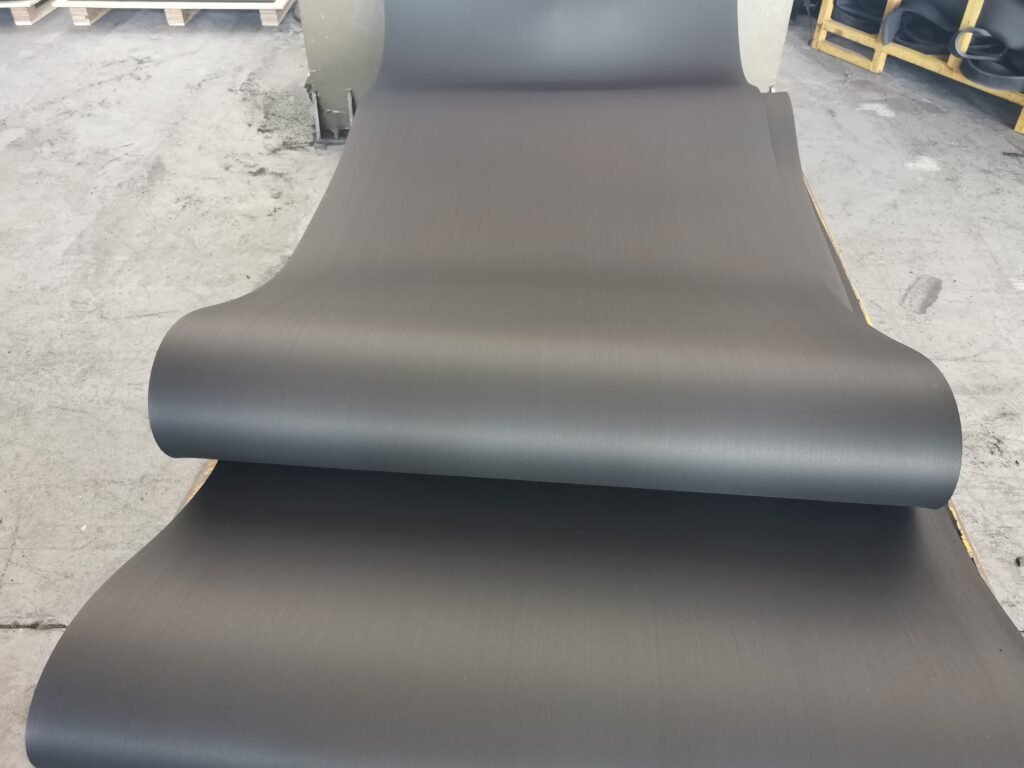
Choosing the right flooring can make all the difference in your gym’s functionality, safety, and aesthetic appeal.
The optimal gym flooring enhances the experience for those who use the facility and provides an essential layer of protection for the gym-goers and the equipment. With the myriad options, selecting the perfect gym flooring can often feel daunting. This comprehensive guide is designed to answer some of the most common questions about gym flooring.
From understanding what gym mats are called to figuring out if rubber or vinyl is better for gym flooring, this guide aims to provide valuable insights and practical solutions for your gym flooring needs. So, let’s dive in and explore the world of gym flooring options together.
What are the Mats in Gyms Called?
Gym mats, a critical component of gym flooring, come in various types, each serving its unique purpose. Below, we delve into the different kinds of mats you’ll often find in a fitness setting:

Rubber Gym Tiles
The most common and durable rubber gym mats offer superior protection and resilience. These mats are often composed of recycled, non-vulcanized, or heavy-duty rubber. They’re favored for their durability, shock absorption, and water resistance.

Interlocking Floor Tiles
Interlocking floor tiles, often made from EVA foam or rubber, provide a seamless flooring solution that’s easy to install. These puzzle pieces create a non-slip, cushioned surface ideal for floor exercises and heavy equipment.

Roll Rubber Flooring
As the name suggests, rolled rubber flooring comes in large rolls that can cover extensive areas. These mats are durable and ideal for commercial gym applications and weight rooms.

Gym Mats
Also known as exercise mats, these are often used for floor exercises or underneath exercise equipment for extra protection. They come in various materials, but foam mats and rubber mats are commonly used due to their shock absorbency and comfort.

Horse Stall Mats
These thick rubber mats, initially designed for horse stalls, have found a place in home gyms and commercial gyms due to their extreme durability and shock absorption. They’re often used in areas with heavy free weights or Olympic lifting.
The type of mat you select for your gym floor will significantly depend on the specific needs of your space and the activities performed. From offering a comfortable surface for floor exercises to providing shock absorption for heavy weights, the right gym mat will enhance safety, performance, and overall experience.

Are Rubber Gym Floor Necessary in Commercial Gym and Home Gyms?
While considering setting up a fitness room or a home gym, one may question the importance of installing gym floor mats. However, gym mats, especially rubber gym floors, are indispensable in ensuring an effective and safe workout environment. Here’s why.
Shock Absorption and Noise Reduction
Among the crucial benefits of gym floor mats is their shock-absorbent quality. Whether it’s a rubber floor tile or a thicker flooring option like rubber rolls, these mats cushion the impact of heavy gym equipment or the dropping of weights. This protects your gym floors, reduces noise, and alleviates the stress on your joints during high-impact workouts.
Water Resistance and Easy Maintenance
Most gym mats, including interlocking tiles and rubber tiles, are non-porous and water-resistant. This trait is essential in commercial fitness centers and home gyms as it helps combat sweat or liquid spills, ensuring a hygienic workout environment. It also prevents potential water damage to the underlying floor. Plus, the low-maintenance nature of these mats saves time and effort in the long run.
Ease of Installation
Whether you’re dealing with a complete fitness room or a small extra room in your house converted to a home gym, installing gym mats is typically straightforward. Interlocking rubber floor tiles, for instance, can be easily fit together like puzzle pieces using a sharp utility knife. Likewise, rubber rolls can be laid down per square foot to cover larger areas. This flexibility allows easy customization of your gym’s layout and simplifies replacements if a section is damaged.
Safety and Comfort
Quality gym mats enhance comfort and safety, whether for your home gym floor or a commercial gym. They provide a non-slip surface for safer workouts and a cushioned surface for floor exercises, ensuring comfort while sitting or lying down.
Protecting Your Gym Equipment
By using gym mats, you extend the lifespan of your gym equipment. The cushioning effect of mats, such as rubber floors or foam tiles, minimizes the wear and tear from direct contact with hard floors.
In conclusion, gym floor mats are more than just an aesthetic addition to your gym. From rubber gym flooring to interlocking tiles, these mats provide critical benefits, including shock absorption, water resistance, and equipment protection. So, regardless of setting up a garage floor gym or designing a commercial fitness center, gym mats are a necessity you would want to pay attention to.

Which Gym Mat is the Best?
Choosing the best mat for your gym largely depends on the activities carried out, the volume of usage, and your specific requirements. Let’s dive into the details of the three widely used gym mats – rubber mats, foam mats, and EVA foam – to help you make an informed decision.
Rubber Mats: The Heavy-Duty Solution
Rubber mats, especially those used for rubber gym flooring, are renowned for their durability and resilience. They are usually the go-to choice for commercial gyms or high-impact areas in home gyms due to their excellent ability to absorb shock, resist water, and withstand heavy weights.
They come in various forms, including rubber floor tiles, interlocking rubber floor tiles, and rubber rolls. While they might be more costly upfront, their long lifespan and low maintenance make them a worthy investment.

Foam Mats: Lightweight and Comfortable
Foam mats are typically lighter and softer, making them an excellent choice for activities like yoga, Pilates, or other floor exercises.
They offer a comfortable surface and decent shock absorption but may be better for areas with heavy equipment or weights. Foam mats are generally cheaper and easier to install, often in interlocking tiles for convenience. However, they may not be as durable as their rubber counterparts.

EVA Foam: The Versatile Option
EVA (Ethylene Vinyl Acetate) foam is a blend of the durability of rubber mats and the softness of foam mats. It is shock-absorbent, water-resistant, and easy to install, usually in the form of interlocking tiles. EVA foam is a good option for mixed-use areas where you need durability but want comfort for floor exercises. It also often comes in different thickness options to suit your specific needs.
In conclusion, the best gym mat depends on your gym’s specific requirements. Rubber mats are your best bet if you’re dealing with heavy weights and need a mat that can take a beating. For floor exercises and lighter workouts, foam mats may suffice. However, if you’re looking for a versatile option, EVA foam strikes a delicate balance between the two.

How Thick Should Gym Mats Be?
The thickness of your gym mats is crucial in providing the proper support, protection, and comfort during workouts. Here’s how to choose the best thickness for your gym mats, especially if you’re using heavy free weights and cardio equipment.
Mats for Cardio Equipment and Strength Machine
If you’re setting up cardio equipment like treadmills, stationary bikes, or elliptical trainers, the mats must be sufficiently dense to absorb vibrations and prevent the equipment from shifting. A gym mat around 25-30mm should be sufficient for most cardio equipment. These mats help reduce noise, protect your floors from potential damage due to the equipment’s weight, and enhance the stability of the machines.

Mats for Heavy Free Weights
You should opt for thicker mats for areas where you’ll be lifting heavy free weights. Dropping weights can cause substantial impact, and thinner mats may not provide adequate protection. Here, a mat with a minimum thickness of 30mm is recommended. For activities such as Olympic lifting, where weights are frequently dropped from a height, consider mats that are 50mm thick.

Mats for Floor Exercises
For floor exercises like yoga, Pilates, or stretching, comfort is critical, and thicker mats can provide better cushioning. A mat at least 20mm thick should offer a comfortable surface for these activities. However, too much thickness can affect stability, especially in standing poses. So, try out different thicknesses and see what feels best for your routine.

Mats for Mixed-use Areas
If you’re setting up a mixed-use area, a versatile gym mat like EVA foam, which comes in various thicknesses, can be a good choice. You can choose a thickness that suits most activities and add extra layers or mats for specific exercises if needed.
In conclusion, the thickness of your gym mat depends on the type of activities and equipment you use in your gym. While there’s no one-size-fits-all solution, understanding your requirements and choosing accordingly can help create a safe and comfortable workout environment.

What Flooring is Best for Gym?
When outfitting a gym – be it a commercial fitness center or a home gym – choosing the right flooring is as crucial as selecting the appropriate equipment. The right gym flooring offers protection for your underlying floors, helps reduce noise, provides safety for users, and contributes to the aesthetic of the gym. This section will examine three popular gym flooring options: rubber gym flooring, interlocking rubber floor tiles, and rolled rubber flooring.
Rubber Gym Tiles
Rubber gym tiles are a classic choice for both commercial and home gyms. Known for its durability, rubber flooring can withstand heavy-duty workout equipment and high-impact exercises.
This flooring option is perfect for areas where heavy free weights are used frequently. Not only does it protect your existing floors from potential damage, but it also offers excellent shock absorption, reducing the risk of injuries. Rubber gym flooring is also water-resistant and easy to clean, making it a low-maintenance choice.

Interlocking Rubber Floor Tiles
Interlocking rubber floor tiles are a versatile choice for any gym. These tiles fit together like puzzle pieces, making installing and replacing individual sections easy if needed.
They provide all the benefits of rubber gym flooring – durability, shock absorption, and water resistance – but with the added benefit of customization. You can mix and match tiles to create patterns, define specific areas within your gym, or accommodate irregular room shapes. Another plus is that installation doesn’t require professional help; it’s a straightforward DIY task with a sharp utility knife.

Rolled Rubber Flooring
For larger gyms or those looking for an economical choice, rolled rubber flooring is a great option. Sold in rolls, this flooring can cover large areas more quickly and cost-effectively than individual tiles. Installation is easy, though more extensive registrations require more than one person. Once laid out and cut to fit, the flooring forms a nearly seamless surface that’s not only durable and shock-absorbent but also offers a clean, professional look. Just like rubber gym flooring and interlocking tiles, rolled rubber is water-resistant, easy to clean, and can handle the wear and tear of a busy gym.

To sum up, the best flooring for your gym depends on your specific needs and circumstances. Rubber gym flooring is an all-around reliable choice, interlocking rubber floor tiles offer versatility and easy installation, while rolled rubber flooring is an economical solution for larger spaces.
Each option will provide a safe, durable, and professional-looking gym floor.
In conclusion, various flooring options, such as home gym flooring, gym tiles, and garage floors, are vital to creating an efficient and comfortable workout environment. Using rubber floors can help in reducing noise and provide a durable and low-maintenance surface. Incorporating cardio equipment and exercise mats can add versatility to your space. Moreover, considering volume pricing might provide an economical approach for larger areas. Regardless of the choice, ensuring safety and comfort is crucial to enhance the overall workout experience.



